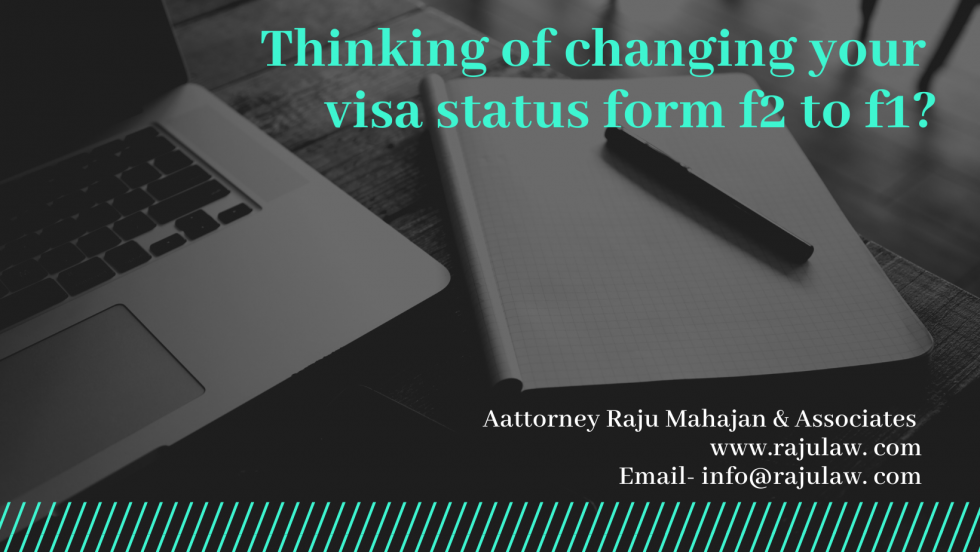When you enter the United States in nonimmigrant status, you do so for a specific purpose, such as study, work, or travel. You may enter the U.S. with one goal and later change your drive. When this happens, you may need to obtain a new status. Different visa/status categories allow various activities. The Law Office of Attorney Raju Mahajan is happy to help you apply to the U. S. Citizenship and Immigration Services (USCIS) to change your nonimmigrant status to F-1 student. Make an appointment if you want to apply.
To change from an F-2 dependent status to F-1 student status, your F-1 spouse or parent must be in the United States and maintain his or her F-1 status throughout the time your application is pending. To change your status from F-2 to F-1, you can either:
A. Travel outside the U.S., apply at a U.S. consulate for F-1 visa type and re-enter the U.S. in the new status or
B. Request a change of status within the U.S. by sending an application to the United States Citizenship and Immigration Services.
Option A: Travel and Reentry
Leave the U.S., apply for a new visa at a U.S. consulate, and re-enter the U.S. with the new visa. You will gain your new status when you are admitted to the U.S. This process is usually faster than changing status in the U.S. and requires less paperwork. Also, you will obtain the visa and status. However, it has two drawbacks: the possibility of delay in visa processing time and travel and ticket expenses.
PROCEDURE
To use this option, follow these steps:
To use this option, follow these steps:
1. Submit “I-20 Request Form” and supporting document– from the last page of this guide. OISSS will issue an initial Form I-20 after reviewing these documents.
2. Pick up your new F-1 student Form I-20, review it, sign and date it on page 1 where indicated.
3. Travel outside the U.S.
4. Apply for an F-1 visa at a U.S. embassy/consulate. Be aware application for the new visa may involve security clearance and could delay your visa issuance.
5. Re-enter the U.S. in new visa status with the new I-20. Please note, you may not re-enter the U.S. more than 30 days before the program start date indicated on your I-20.
6. Report to OISSS upon your return to EKU and bring your passport, I-94, and I-20. Failure to do so on time may result in the cancellation of your SEVIS record.
Option 2: Change Status in the U.S
Submit an application to the U.S. Citizenship and Immigration Services (USCIS) for a change of status. This option allows you to change your status while remaining in the U.S. With this option, you may gain a new status but you will not receive a new visa; visas are only issued outside the U.S. when you travel back to your home country. This will allow you to stay in the U.S. during processing. However, this process can be prolonged (three to six months). Also, you must stay in the U.S. during processing; exiting the U.S. cancels the application. You must also obtain a visa stamp to match your status the next time you travel outside the U.S. (except for trips under 30 days to Canada or Mexico). The major disadvantage is that the application may be denied, requiring you to depart the U.S quickly.
ELIGIBILITY
In general, you are eligible to apply for a change of status inside the U.S. if:
• Your current nonimmigrant status remains valid.
• You meet the requirement to be F-1 dependent.
• Your current status does not prohibit the change of status in the U.S. See restrictions below.
RESTRICTIONS TO CHANGE OF STATUS
The following individuals are ineligible to apply for a change of status inside the U.S.:
• Individuals in J status who are subject to the 212 (e) two-year home-country residency requirement.
• Persons who are admitted under the Visa Waiver Program (WT or WB).
• Persons who hold C, D, or K status cannot change nonimmigrant status.
• A vocational student in M status cannot change to F status.
IMPORTANT NOTES:
• This change of status application changes your immigration status: IT DOES NOT GRANT YOU A VISA. The next time you travel outside the U.S., you will be required to go to a U.S. consulate or embassy abroad to apply for an F-1 visa.
• F-1 on-campus employment is not authorized until the change of status has been approved by the USCIS
• If your change of status is not approved by the program start date printed on the I-20 form, you MUST contact your international student adviser immediately to discuss deferral of the program start date.
• You must be accepted for a full course of study and have the financial ability to support the costs of living and studying in the U.S.
• You and your primary F-1 visa holder must still maintain status on the date you file the change of status application. In other words, your F-2 visa status must not have expired at the time of change of status application.
• To be eligible for Optional Practical Training (OPT) after the change of your status to F-1, you must have been enrolled full-time for at least one academic year before applying for OPT.
• Your will not be eligible to enroll in a full-time program until the change of status is approved. However, F-2 are now eligible to study part-time without changing their status.
• Processing times vary, so be prepared to wait three to six months to learn your application’s outcome. To review current processing times and your pending case status, visit the USCIS case status service online.
• USCIS will notify you of their decision with Form I-797 Notice of Action. The I-797 is an important document and should be kept with your passport and I-94 card. The denial letter or approval notice will be mailed to the address listed on Form I-539 in your application. If you change your address, the postal service will not forward mail sent to you by USCIS. Please provide the International Center with a copy of your I-797/Notice of Action and approval notice.
• You may remain in the U.S. while your application is pending, even if your original status expires during the application processing.
• Do not travel outside of the U.S. while your change of status case is pending. If you leave the country, USCIS will consider your application abandoned.
PROCEDURE
To file for a change of status within the U.S., submit to USCIS the following documents:
1. Check or money order of $370 made payable to “U.S. Department of Homeland Security” or completed Form G- 1450 for credit card payment.
2. A letter from you requesting the change of status and explaining why you want to change status.
3. Financial document (such as four months’ bank statements or scholarship letter)
4. Photocopy of your new F-1 Student Form I-20 issued by OISSS.
5. Photocopies of your Current F-2 Immigration Documents:
a) F-2 Form I-20s.
b) Valid passport biographical page
c) F-2 student visa (except for Canadians and Bermudians)
d) I-94 printout or paper card (front & back)
6. Photocopies of your Spouse or Parent’s Current F-1 Immigration Documents:
a) Valid passport biographical page
b) F-1 student visa (except for visa-exempt citizens of Canada and Bermuda)
c) I-94 printout or paper card (front & back)
d) Official transcripts showing your spouse or parent have been maintaining the status
7. Evidence of financial support (such as a three month’s bank statements or scholarship letter, not older than six months) showing the availability of at least $33,706 for undergraduate or $29,482 for graduate, plus $4,500 for a spouse and $3,000 for each child included on your application.
Note: If you have dependents who are changing status with you, submit copies of their passports, visas, and I-94s. Make photocopies of all the documents for your record.

